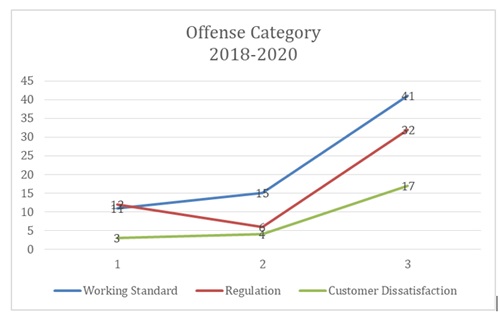ANALISIS PENGARUH WAKTU DAN JARAK PERJALANAN KAPAL TERHADAP BIAYA LOW SULPHUR SURCHARGE
Downloads
The danger of ship emission caused by HFO (Heavy Fuel Oil) fuel type has become a serious matter due to its high containment of sulphur as much as 3.50% m/m. The IMO (International Maritime Organization) took action on this problem by releasing new regulation to limit sulphur in the ship fuel as low as 0.50% m/m. This regulation leads to an additional tariff called the LSS (Low Sulphur Surcharge). As an impact, shipping companies charge this fee to customers and ocean freight forwarders, hence there is an increase of the total shipping charges. Meanwhile, the dominant variable which determines the LSS charge amount is not yet known, so it is still uninformative for the public and the academic field. The purpose of this study is to analyse which variable gives the most influence on the amount of the LSS tariff. By using multiple linear regression method, the study finds that the shipping distance variable is the dominant variable with a contribution value of 86.48% and has positive relationship with the LSS tariff. On the other hand, though the voyage time also has influence on the tariff, the effect is weak and it shows negative relationship with the LSS tariff.
Downloads
Editor. (7 February, 2020) Advantages of Maritime Transport. Blue Ocean Magazine. Available at: https://blueoceanmag.com/advantages-of-maritime-shipping/
R. Rumaji and A. Adiliya, "Port maritime connectivity in South-East Indonesia: A new strategic positioning for transhipment port of Tenau Kupang," The Asian Journal of Shipping Logistics, vol. 35, no. 4, pp. 172-180, 2019. Available at: https://doi.org/10.1016/j.ajsl.2019.12.004
J. G. Speight, Environmental Analysis and Technology for the Refining Industry. Wiley, 2005. Available at: https://books.google.co.id/books?id=UM4cQUj7g6QC
IMO. (2020). IMO 2020 – cutting sulphur oxide emissions Available at: https://www.imo.org/en/MediaCentre/HotTopics/Pages/Sulphur-2020.aspx Accessed on: 28 April, 2021.
Surat Edaran Tentang Kewajiban Penggunaan Bahan Bakar Low Sulfur dan Larangan Mengangkut atau Membawa Bahan Bakar yang Tidak Memenuhi Persyaratan serta Pengelolaan Limbah Hasil Resirkulasi Gas Buang dari Kapal Kementerian Perhubungan Surat Edaran No. 35 Tahun 2019, Available at: https://jdih.dephub.go.id/assets/uudocs/seEI/2019/SE_35_TAHUN_2019_TENTANG_KEWAJIBAN_PENGGUNAAN_BAHAN_BAKAR_LOW_SULFUR_DAN_LARANGAN_MENGANGKUT_ATAU_MEMBAWA_BAHAN_BAKAR.pdf.
D. Huang et al., "Lifespan cost analysis of alternatives to global sulphur emission limit with uncertainties," Journal of Engineering for the Maritime Environment, vol. 00, no. Special Issue Article, 2020. Available at: https://doi.org/10.1177/1475090220983140
Shapiro. (2020). Low Sulfur Surcharge: High Confusion and High Costs. Available at: https://www.shapiro.com/low-sulfur-surcharge-high-confusion-and-high-costs/ Accessed on: 5 July, 2021.
H. Manaadiar. (14 December 2018). What is Low Sulphur Surcharge and why is it applicable..?? Available at: https://www.shippingandfreightresource.com/what-is-low-sulphur-surcharge-and-why-is-it-applicable/ Accessed on: 5 July, 2021.
T. Notteboom, "The impact of low sulphur fuel requirements in shipping on the competitiveness of roro shipping in Northern Europe," WMU Journal of Maritime Affairs, vol. 10, no. 1, pp. 63-95, 2011/04/01 2011. Available at: https://link.springer.com/article/10.1007%2Fs13437-010-0001-7
U. Shuaibu, "The economic impact of low sulphur compliance on future fuel cost and container freight rates: a case study of Shanghai-Lagos," Master of Science, Shipping Management and Logistics, World Maritime University, 2019,Available at: https://commons.wmu.se/all_dissertations/1121?utm_source=commons.wmu.se%2Fall_dissertations%2F1121&utm_medium=PDF&utm_campaign=PDFCoverPages.
S. Rahm, "The costly future of green shipping," in "Schroders," 2015, Available at: https://www.schroders.com/pl/sysglobalassets/digital/insights/pdfs/the-costly-future-of-green-shipping-schroders.pdf.
C. Sys et al., "International emission regulation in sea transport: Economic feasibility and impact," Transportation Research Part D: Transport and Environment, vol. 45, pp. 139-151, 2016. Available at: https://doi.org/10.1016/j.trd.2015.06.009
P.-C. Wu and C.-Y. Lin, "Cost-Benefit Evaluation on Promising Strategies in Compliance with Low Sulfur Policy of IMO," Journal of Marine Science and Engineering, vol. 9, no. 1, p. 3, 2021. Available at: https://doi.org/10.3390/jmse9010003
M. M. Golias et al., "The berth allocation problem: Optimizing vessel arrival time," Maritime Economics & Logistics, vol. 11, no. 4, pp. 358-377, 2009/12/01 2009. Available at: https://doi.org/10.1057/mel.2009.12
E. Bal Beşikçi et al., "An artificial neural network based decision support system for energy efficient ship operations," Computers & Operations Research, vol. 66, pp. 393-401, 2016/02/01/ 2016. Available at: https://doi.org/10.1016/j.cor.2015.04.004
ShipHub. (2021). LSF/LSS in Sea Freight. Available at: https://www.shiphub.co/lsf-lss-in-sea-freight/ Accessed on: August 5, 2021.
A. Kerriou. (February 10, 2020). "Low Sulfur" Regulations: the Impact on Maritime Shipping Prices. Available at: https://market-insights.upply.com/en/low-sulfur-regulations-the-impact-on-maritime-shipping-prices Accessed on: August 4, 2021.
N. H. Said. (15 January 2020). Bikin Biaya Logistik Membengkak, Asosiasi Perusahaan Logistik Tolak LSS. Available at: https://rakyatku.com/read/176515/bikin-biaya-logistik-membengkak-asosiasi-perusahaan-logistik-tolak-lss Accessed on: 5 July, 2021.
Editor. (January 13, 2020). Dampak IMO 2020, Tarif Angkut Kontainer Domestik Melonjak. Available at: https://jurnalmaritim.com/dampak-imo-2020-tarif-angkut-kontainer-domestik-melonjak/ Accessed on: August 24, 2020.
D. Sudrajat, "Segmentasi pasar penyedia jasa logistik (third party logistics) di Indonesia," Binus Business Review, vol. 1, no. 2, pp. 332-341, 2010. Available at: https://doi.org/10.21512/bbr.v1i2.1079
T. Prasetya. (2017, 22 September). Tren positif sektor freight forwading di Indonesia. Available at: https://industri.kontan.co.id/news/tren-positif-sektor-freight-forwading-di-indonesia
R. M. Azka. (2020, 19 July ). Aturan Ini Tumpang Tindih, Freight Forwarder Geleng Kepala. Available at: https://ekonomi.bisnis.com/read/20200719/98/1268133/aturan-ini-tumpang-tindih-freight-forwarder-geleng-kepala
N. Bialystocki and D. Konovessis, "On the estimation of ship's fuel consumption and speed curve: A statistical approach," Journal of Ocean Engineering Science, vol. 1, no. 2, pp. 157-166, 2016. Available at: https://doi.org/10.1016/j.joes.2016.02.001
L. Bui-Duy and N. Vu-Thi-Minh, "Utilization of a deep learning-based fuel consumption model in choosing a liner shipping route for container ships in Asia," The Asian Journal of Shipping and Logistics, vol. 37, no. 1, pp. 1-11, 2021/03/01/ 2021. Available at: https://doi.org/10.1016/j.ajsl.2020.04.003
H. Andersson et al., "Integrated maritime fleet deployment and speed optimization: Case study from RoRo shipping," Computers & Operations Research, vol. 55, pp. 233-240, 2015/03/01/ 2015. Available at: https://doi.org/10.1016/j.cor.2014.03.017
T. P. V. Zis et al., "Policy measures to avert possible modal shifts caused by sulphur regulation in the European Ro-Ro sector," Transportation Research Part D: Transport and Environment, vol. 70, pp. 1-17, 2019/05/01/ 2019. Available at: https://doi.org/10.1016/j.trd.2019.03.001
CNC. (January 28, 2021). Intra-Asia Market: Low Sulphur Surcharge (LSS) Update for March 2021. Available at: https://www.cnc-ebusiness.com/news/113/intra-asia-market-low-sulphur-surcharge-lss-update-for-march-2021 Accessed on: August 5, 2021.
Maersk. (July 2, 2019). Rate Announcements: Scope Far East Asia to Mediterranean. Available at: https://www.maersk.com/news/articles/2019/07/02/ra-scope-far-east-asia-mediterranean Accessed on: August 5, 2021.
Bacargo. (2019). Informasi Biaya Low Sulfur Surcharge (LSS). Available at: https://bahteraandalan.com/blog/informasi-biaya-low-sulfur-surcharge.html Accessed on: August 5, 2021.
M. Kasiram, Metodologi penelitian kuantitatif dan kualitatif (Malang: UIN-Malang Pers). 2008. Available at: http://repository.uin-malang.ac.id/1621/
L. R. Shanock et al., "Polynomial Regression with Response Surface Analysis: A Powerful Approach for Examining Moderation and Overcoming Limitations of Difference Scores," Journal of Business and Psychology, vol. 25, no. 4, pp. 543-554, 2010/12/01 2010. Available at: https://doi.org/10.1007/s10869-010-9183-4
K.-h. Lai et al., "Are trade and transport logistics activities mutually reinforcing? Some empirical evidences from ASEAN countries," Journal of Shipping and Trade, vol. 4, no. 1, p. 2, 2019/04/26 2019. Available at: https://10.1186/s41072-019-0041-x
N. Pandis, "Multiple linear regression analysis," American Journal of Orthodontics and Dentofacial Orthopedics, vol. 149, no. 4, p. 581, 2016/04/01/ 2016. Available at: https://doi.org/10.1016/j.ajodo.2016.01.012
Y. Wibisono, Metode Statistik, 1 ed. Yogyakarta: Gadjah Mada University Press, 2005. Available at: http://ugmpress.ugm.ac.id/en/product/arsitektur/metode-statistik
S. Aisyah and K. Kuswantoro, "Pengaruh Pendapatan, Harga Dan Nilai Tukar Negara Mitra Dagang Terhadap Ekspor Crude Palm Oil (CPO) Indonesia," Jurnal Ekonomi-Qu, vol. 7, no. 1, 2017. Available at: http://dx.doi.org/10.35448/jequ.v7i1.4221
L. M. Wulandari and S. Zuhri, "Pengaruh Perdagangan Internasional Terhadap Pertumbuhan Ekonomi Indonesia Tahun 2007-2017," Jurnal REP (Riset Ekonomi Pembangunan), vol. 4, no. 2, pp. 119-127, 2019. Available at: http://dx.doi.org/10.31002/rep.v4i2.781
R. Permanasari, "Pengaruh Motivasi dan Lingkungan Kerja Terhadap Kinerja PT. Augrah Raharjo Semarang," Management Analysis Journal, vol. 2, no. 2, 2013. Available at: https://doi.org/10.15294/maj.v2i2.2493
M. Anshori, Metodologi Penelitian Kuantitatif : Edisi 1. Airlangga University Press, 2019. Available at: https://books.google.co.id/books?id=ltq0DwAAQBAJ
G. Norman, "Likert scales, levels of measurement and the "laws” of statistics," Advances in Health Sciences Education, vol. 15, no. 5, pp. 625-632, 2010/12/01 2010. Available at: https://10.1007/s10459-010-9222-y
J. R. Evans and W. M. Lindsay, An Introduction to Six Sigma and Process Improvement. Cengage Learning, 2014. Available at: https://books.google.co.id/books?id=CYHAAgAAQBAJ
T. K. Kim and J. H. Park, "More about the basic assumptions of t-test: normality and sample size," (in eng), Korean journal of anesthesiology, vol. 72, no. 4, pp. 331-335, 2019. Available at: https://10.4097/kja.d.18.00292
I. Ghozali, Aplikasi analisis multivariate dengan program SPSS. Badan Penerbit Universitas Diponegoro, 2006. Available at: https://books.google.co.id/books?id=JdqJAQAACAAJ
D. N. A. Janie, Statistik deskriptif & regresi linier berganda dengan SPSS. Semarang University Press, 2012. Available at: https://repository.usm.ac.id/files/bookusm/B208/20170519022209-Statistik-Deskriptif-%26-Regresi-Linier-Berganda-dengan-SPSS.pdf
A. Marzuki et al., Praktikum Statistik. Ahli Media Press, 2020. Available at: https://books.google.co.id/books?id=-_kOEAAAQBAJ
M. Nisfiannoor, Pendekatan statististika Modern untuk Ilmu Sosial. Penerbit Salemba. Available at: https://books.google.co.id/books?id=1j_O7aHTZD8C
I. Gani and S. Amalia, Alat Analisis Data: Aplikasi Statistik untuk Penelitian Bidang Ekonomi dan Sosial. Penerbit Andi. Available at: https://books.google.co.id/books?id=1FSiCgAAQBAJ
Dr Muhammad Yusuf and D. M. Nastiti, Analisis Data Penelitian : Teori & Aplikasi dalam Bidang Perikanan. PT Penerbit IPB Press, 2019. Available at: https://books.google.co.id/books?id=qrkREAAAQBAJ
D. Siagian, Metode statistika untuk bisnis dan ekonomi. Gramedia Pustaka Utama, 2000. Available at: https://books.google.co.id/books?id=saZED8D4mpsC
S. Hadi, Analisis Regresi. Penerbit Andi. Available at: https://books.google.co.id/books?id=ByzBslce0zsC
B. Utomo, "Hubungan Antara Konsumsi Bahan Bakar dengan Berbagai Perubahan Kecepatan pada Motor Diesel Penggerak Kapal," Jurnal Rekayasa Mesin, vol. 15, no. 2, pp. 163-170, 2020. Available at: http://dx.doi.org/10.32497/jrm.v15i2.1957
J. P. Rodrigue, The Geography of Transport Systems. Taylor & Francis, 2020. Available at: https://books.google.co.id/books?id=EGIPEAAAQBAJ
Y.-R. Kim et al., "Development of a Fuel Consumption Prediction Model Based on Machine Learning Using Ship In-Service Data," Journal of Marine Science Engineering, vol. 9, no. 2, p. 137, 2021. Available at: https://doi.org/10.3390/jmse9020137
E. Ostertagova, "Modelling Using Polynomial Regression," Procedia Engineering, vol. 48, pp. 500–506, 12/31 2012. Available at: https://doi.org/10.1016/j.proeng.2012.09.545
S. Darshana and A. Maura, "Polynomial Regression and Response Surface Methodology: Theoretical Non-Linearity, Tutorial and Applications for Information Systems Research," Australasian Journal of Information Systems, vol. 23, no. 0, 09/23 2019. Available at: https://doi.org/10.3127/ajis.v23i0.1966
J. S. Malensang et al., "Pengembangan Model Regresi Polinomial Berganda pada Kasus Data Pemasaran," Jurnal Ilmiah Sains, vol. 12, no. 2, pp. 149-152, 2013. Available at: https://doi.org/10.35799/jis.12.2.2012.740
D. F. Hamilton et al., "Interpreting regression models in clinical outcome studies," (in eng), Bone & joint research, vol. 4, no. 9, pp. 152-153, 2015. Available at: https://doi.org/10.1302/2046-3758.49.2000571
JMIL Jurnal Manajemen Industri dan Logistik (Journal of Industrial and Logistics Management) is an Open Access Journal. The authors who publish the manuscript in JMIL Jurnal Manajemen Industri dan Logistik agree to the following terms:

JMIL Jurnal Manajemen Industri dan Logistik is licensed under a Creative Commons Attribution 4.0 International License. This permits anyone to copy, redistribute, remix, transmit and adapt the work provided the original work and source is appropriately cited.
This means:
(1) Under the CC-BY license, authors retain ownership of the copyright for their article, but authors grant others permission to use the content of publications in JMIL Jurnal Manajemen Industri dan Logistik in whole or in part provided that the original work is properly cited. Users (redistributors) of JMIL Jurnal Manajemen Industri dan Logistik are required to cite the original source, including the author's names, JMIL Jurnal Manajemen Industri dan Logistik as the initial source of publication, year of publication, volume number, issue, and Digital Object Identifier (DOI); (2) Authors grant JMIL Jurnal Manajemen Industri dan Logistik the right of first publication. Although authors remain the copyright owner.




























